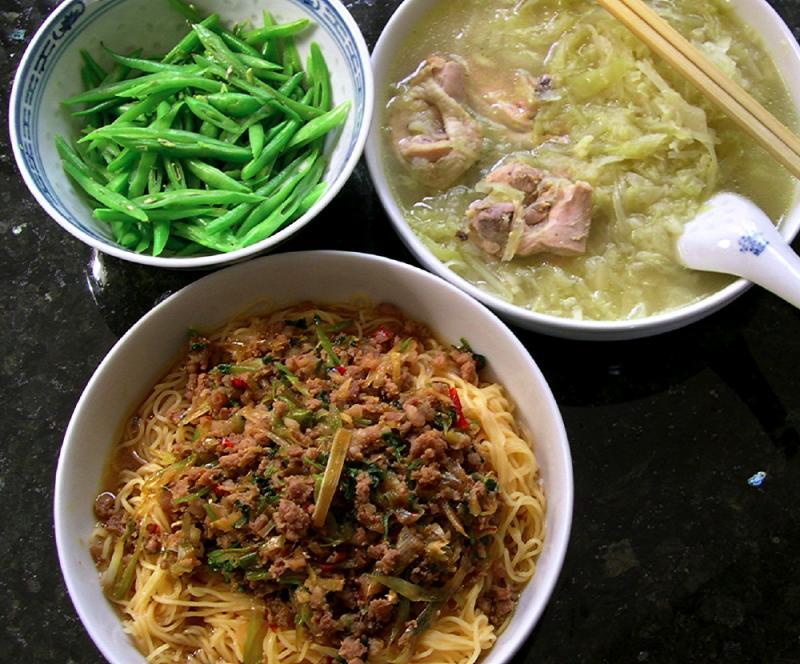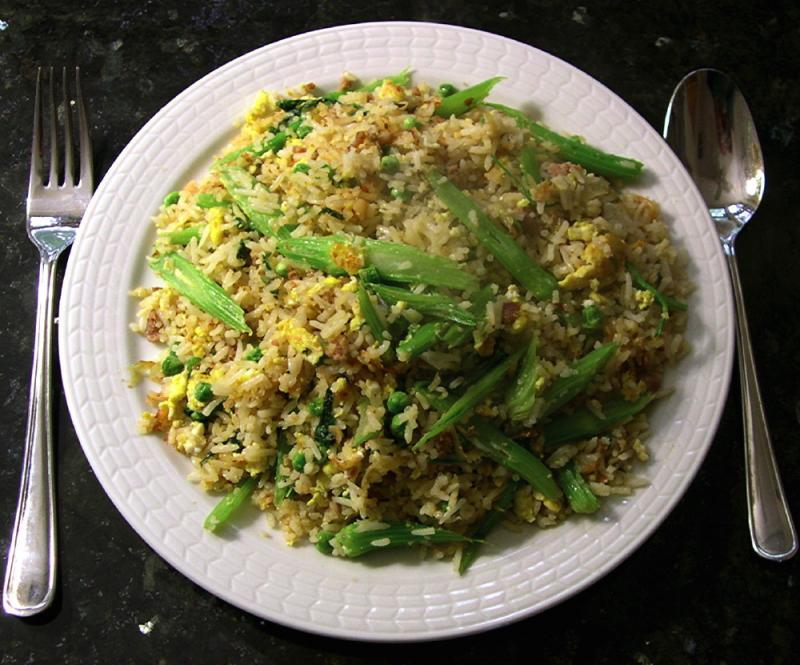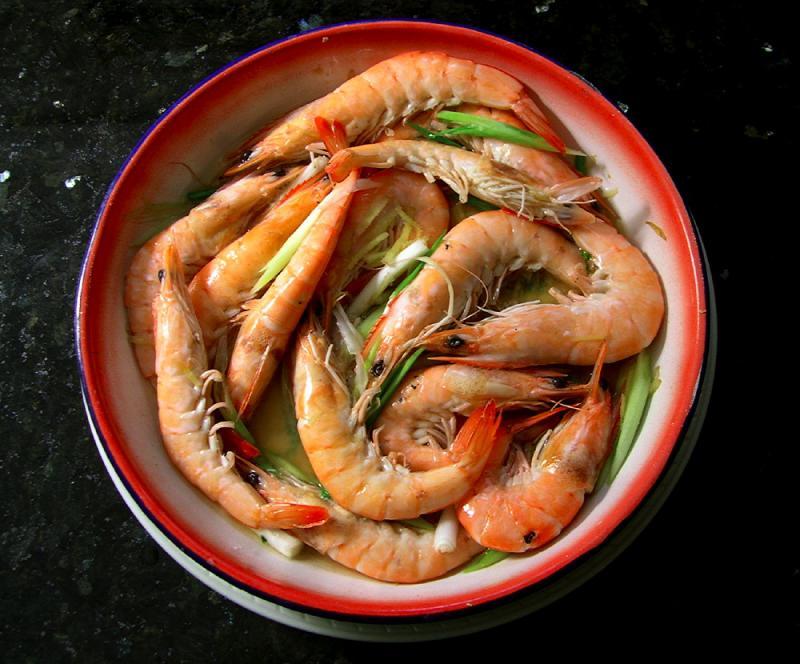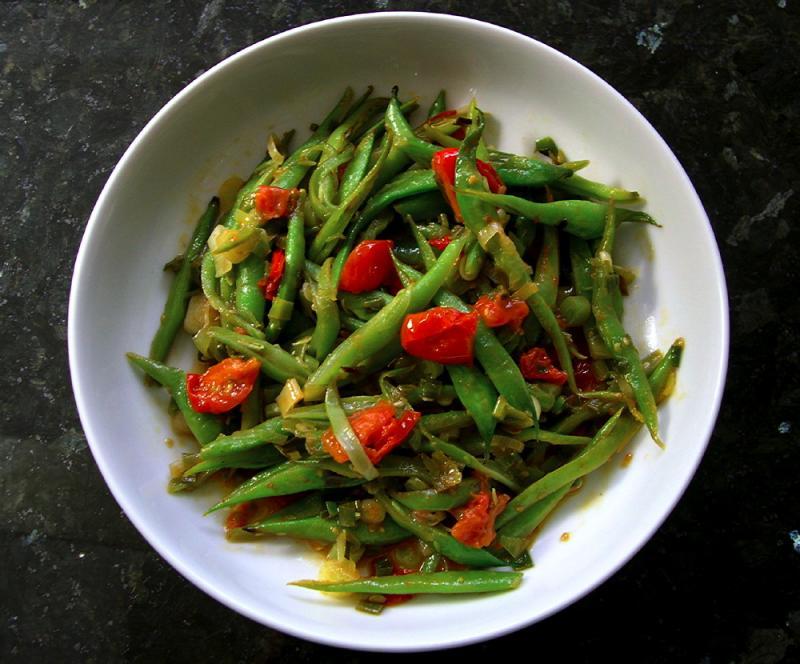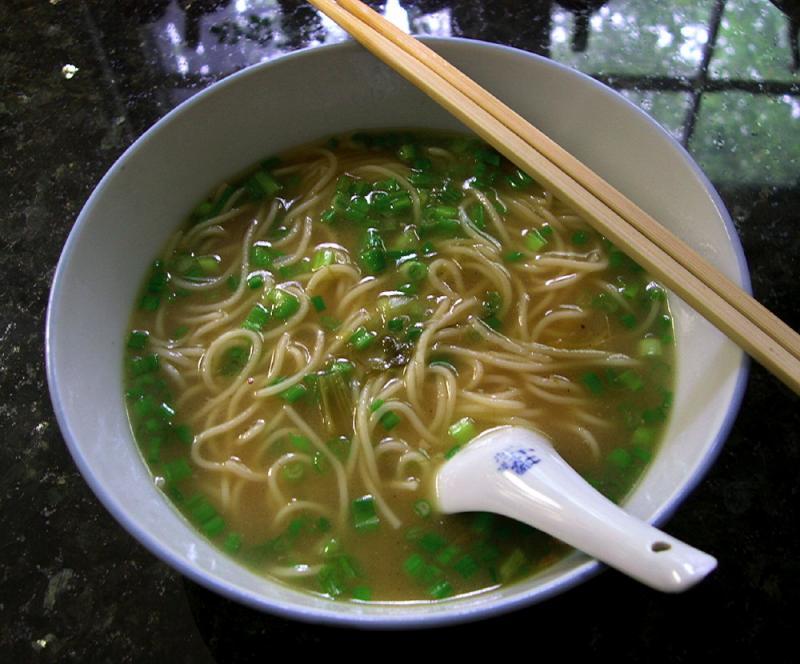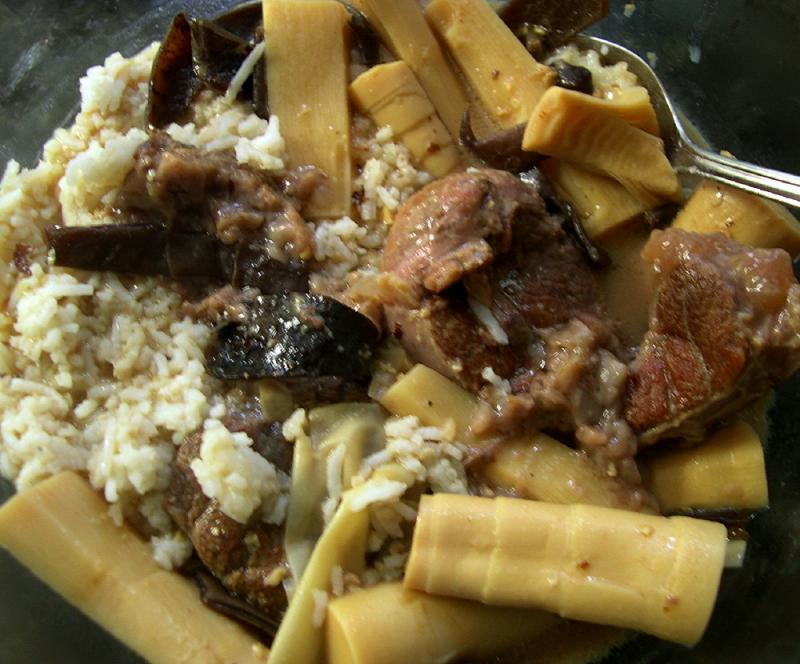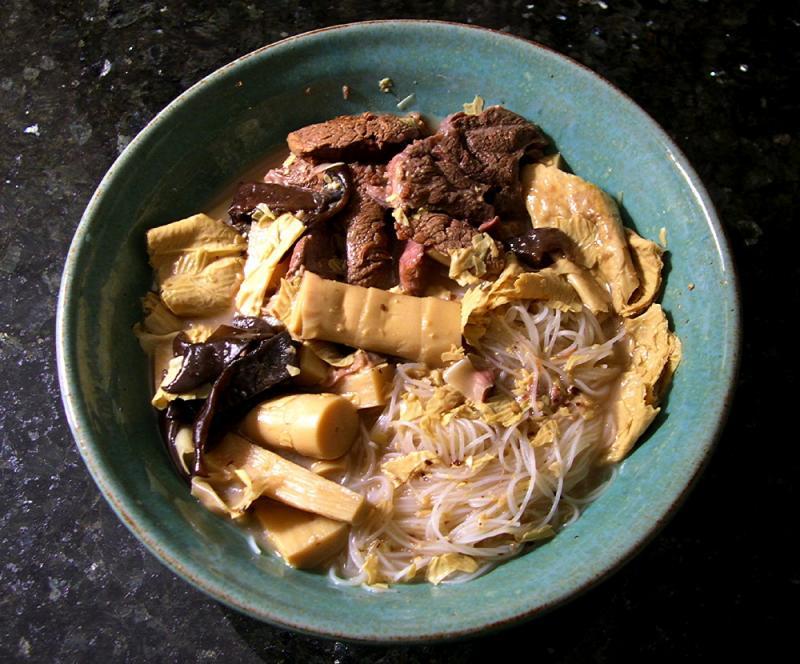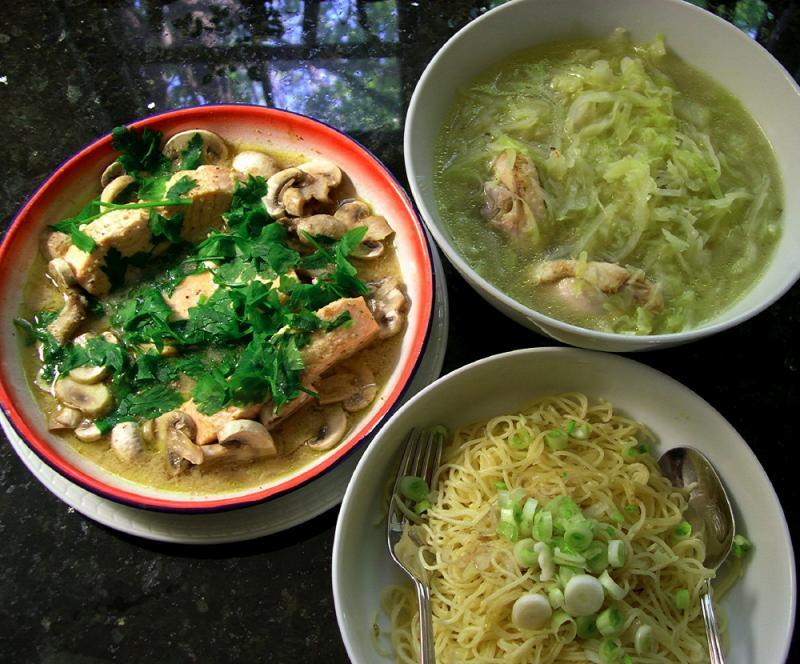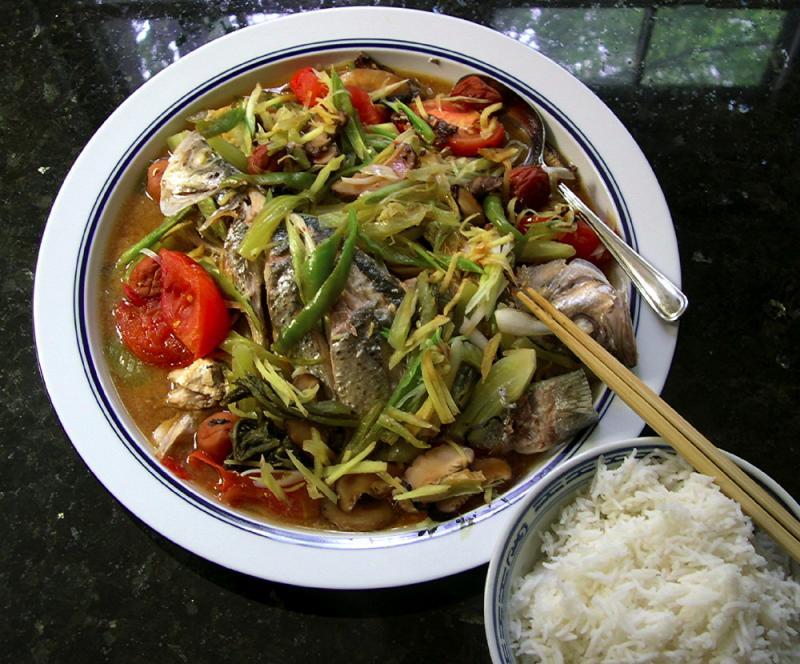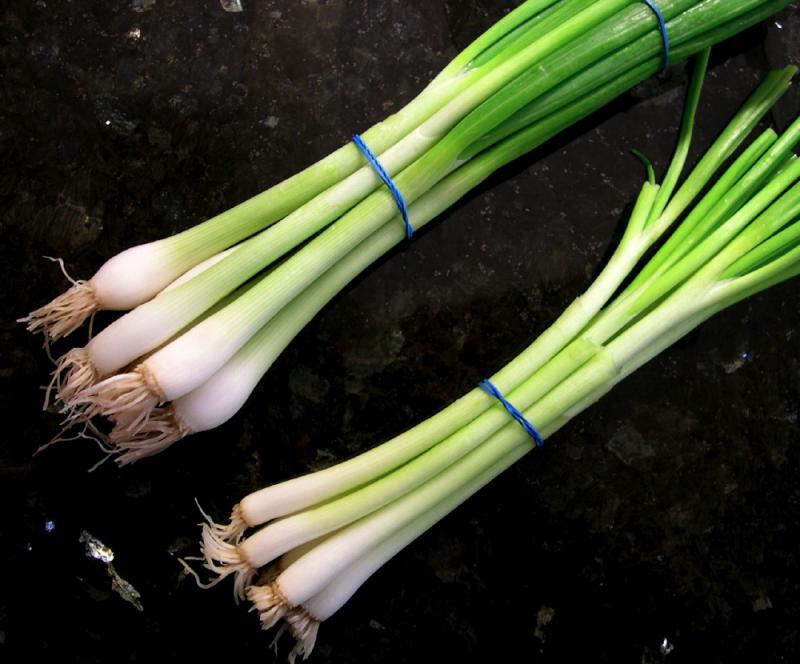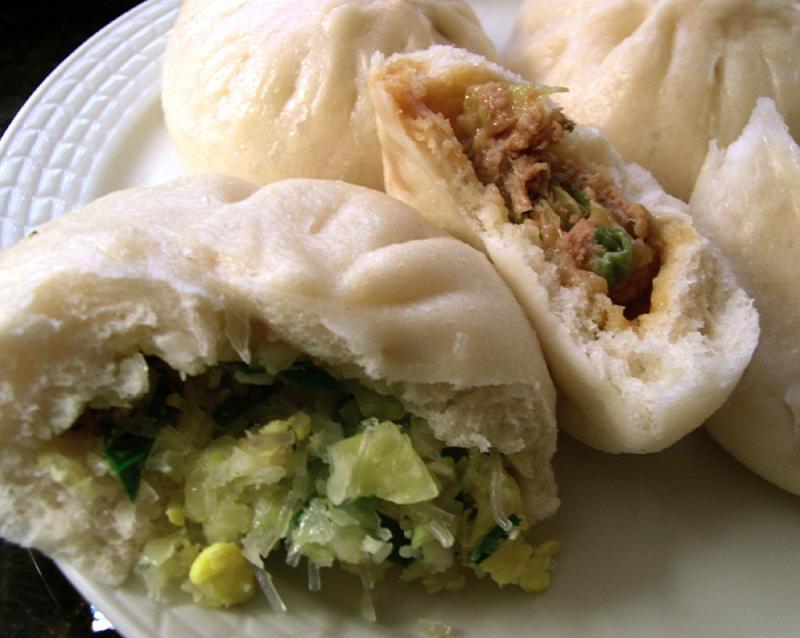-
Posts
3,810 -
Joined
-
Last visited
Content Type
Profiles
Forums
Store
Help Articles
Everything posted by huiray
-
2013-0509 Lunch • “Kon Lo Mein” with minced pork sauce on skinny wonton noodles.¶ • French-cut Roma beans, simply sautéed w/ EV olive oil (Arbequina) [unio] & sea salt. • Cabbage & Chicken soup, from lunch yesterday. ¶ Minced pork was marinated w/ fish sauce containing chili & whole anchovies (Mam ca com an lien) [Quang Tri Food (Hanoi)] (this one), Sambal Bangkok [Kokita], clear fish sauce [Red Boat], peanut oil [Oriental Mascot], Shaohsing wine [Wei Chuan], sesame oil [Dragonfly], fresh ground white pepper. Thickly-sliced (on the bias) scallions (white parts mainly, some green parts) & chopped smashed garlic were sautéed in peanut oil, the maninated minced pork added and stirred around/sautéed. Chopped coriander leaves were added and the heat turned off. ------------------------------------ 2013-0509 Dinner • White rice (Basmati) with some of the leftover sauce from lunch. • The remainder of the chicken & cabbage soup, augmented w/ fresh thinly-sliced green cabbage & simmered a short while. (fresh cabbage still slightly crunchy, “old” cabbage now meltingly soft – nice contrast of textures) ------------------------------------- 2013-0510 Lunch • Fried rice. Oil in hot pan, chopped smashed garlic, trimmed Chinese celery (largely stems), three eggs scrambled in situ, 2-day-old Basmati rice, rest of the sauce for the “Kon Lo Mein” from the day before, largely thawed (frozen) peas. In that order, more or less. -------------------------------------- 2013-0511 Lunch • Farmed saltwater Pacific White Shrimp¶ simply steamed w/ scallions, ginger, a bit of chopped garlic, sea salt, small splash of mirin & ryori-shu. • Button mushrooms, fresh asparagus & snow fungus medley.§ • White rice (Basmati). ¶ Harvested the day before at Bedrock Springs Seafood Farm in land-locked Indiana. (See here too) On ice, never frozen. Bought at today’s local Farmers’ Market. Yum. No deveining needed. Content of heads succulent, all were sucked out and eagerly devoured. § Halved button mushrooms were sautéed & lightly browned in Arbequina EV olive oil [unio], trimmed asparagus (from today's Farmers' Market; cut yesterday) added & tossed. Snow fungus† (“Snow ears”, 雪耳; or “Silver Ears”, 銀耳; Tremella fuciformis) & stock was added and the mix tossed briefly and the heat shut off. † Snow fungus was rehydrated in water, trimmed, then simmered in light chicken stock (just enough to cover) for a little while.
-
This is useful, thanks for posting! The info and notes will be valuable for lots of folks. In truth, however, I seldom dehead and gut my ikan bilis. That slight bitter edge is a useful foil to the rest of the taste profile, and I normally do not mind it, depending to an extent on the type and/or size of the ikan bilis. For that matter, it's relatively rare that you would get deep-fried deheaded and gutted ikan bilis for one's nasi lemak in Malaysia, for example, or in various examples of sambal - although the deheaded/gutted versions also exist. On a related note, there is a current thread on what one's favorite fish is elsewhere on the cooking subforum - the OP there talks about pike mackerel and how he really likes it...while another eGulleteer wonders about it. It might be noted that grilled whole pike mackerel is highly appreciated in Japan & Korea (& elsewhere), where the slight bitterness from the "whole fish and stuff" is SUPPOSED to be part of the appeal and is favored BECAUSE of it.
-
Not deconstructionist drivel? Really?I actually thought we ate ethnic food because it was exciting, exotic, and a change from our normal eating habits. To think I was really suppressing my inner prejudices. As a psychologist who tests these sorts of statements for veracity using experiments all I can say is the author is guilty of unsupported assertions using as its basis a socio-political framework that deconstructs the foodie phenomenon. Call it what you will but I'll call it what I did above. Uhh, I didn't say it *wasn't* "deconstructionist drivel". I said I wasn't sure I would call it that, which is not the same thing, basically because I have not read the book. Neither have you, I gather. What you quoted seems to be the words of the REVIEWER (in my reading of that review), upon which much opprobrium has already been heaped by folks here very worked up over it. :-)
-
Um, "Koon Yick" is a brand and could mean a lot of different sauces. Even with the chili sauces there is more than one. Which one is it that you folks are obsessing over?
-
Whatever fresh fish I'm having at the moment, as others have said. Nevertheless, I do sort-of miss some that I haven't had in a while - "Soon Hock" (Marbled Goby), Garoupa, "Hak Chong" (Black Pomfret), etc. Whether that constitutes their being my "best tasting fish" is debatable and probably untrue.
-
Hahaha!! Someone I knew would faint at the very notion.¶ Cook and eat a blue-eyed pleco? Like the one she kept and which she swore winked at you and followed your movements around? Heh. ¶ Although I presume you mean the related ones, not the blue-eyed pleco. :-)
-
You think so? Interesting point. I'm not sure I'd call it "(deconstructionist) drivel", though - howsoever much one may dislike her approach. But I've not read the book itself either. I wonder, as you say, whether she described her idea of a "good approach" to food. I could see, though, how that might lead to accusations of interpreting the data on the basis of a personal subjective standard, which no doubt lots of folks would disagree with. Damned if you do, damned if you don't? I'm not competent in analysis of the Social Sciences and their methods, though - would such an approach as hers as you infer be not uncommon in the field, or is it an exception? What does come over from the posts on this thread, though, is that folks consider the review (and the book) to be an attack upon their food sensibilities and are venting hot words.
-
The Myers article is indeed somewhat over-the-top even if it is entertaining in its own way. To be fair, It *was* dissed by Anderson in the first paragraph of the review where it was pointed out (in effect) that Myers was a vegan¶ - which makes sense in terms of the diatribe unleashed in that article against meat-eating folks. Just sayin'. [That Myers polemic stirred up quite a few people when it came out. :-) It was also noted that he was an animal-rights activist. ;-) ] ¶ See also: http://blogs.villagevoice.com/forkintheroad/2011/02/yes_foodies_are.php http://www.salon.com/2011/02/11/br_myers_moral_crusade_against_foodies/
-
I used to love Hershey's Special Dark years and years ago, bought it by the multiples at a time. Now, I dislike it. It's not so much the taste as it is the texture - it just seems so...rough and crude, crumbly even. I like Lindt or Ghirardelli nowadays, in terms of widely-available US chocolates - but always the "dark" or high cacao ones. (Yes, both are of Swiss origins) I think Godiva is over-rated. I've always disliked the "milk" chocolates of any brand. Much too sweet and cloying for my tastes, even when I loved that Hershey's Special Dark.
-
2013-0506 Lunch • Shanghai Yangchun Noodles (上海陽春麵) in duck & Chinese celery broth, with finely chopped scallions (green parts only).¶ • Roma beans, sliced diagonally (“French-cut”) sautéed w/ chopped garlic, chopped scallions (mainly white parts), halved Cherub cherry tomatoes. Salted to taste. ¶ This is closer to the more common simple version of the dish, without other add-ons and other stuff or meat pieces and whatnot put in, than what I did for lunch last week. I did use the heavier duck stock-->broth I made beforehand, rather than the lighter broths (chicken, shrimp, etc) more usual; and I also skipped the cut-up thin plain egg omelette often used. (See here and here and here for examples) The duck stock: Duck wings & drumettes were chopped crosswise into two pieces then with the wing tips tossed w/ “luscious soy sauce” (甘醇油膏) [Kim Lan], sufficient sweet mirin [Honteri], ryori-shu [MRT], veggie oil, a bit of oyster sauce [Lee Kum Kee], fresh ground black pepper, a dash of light soy sauce [Pearl River Superior]; then roasted in the oven till lightly caramelized. The duck pieces plus the liquids/scrapings were then transferred to a pot and simmered in water w/ Chinese celery & sliced fresh ginger for several hours or so. Seasoning was adjusted. This gave a fragrant somewhat opaque stock packed with gelatin and which solidified completely on cooling overnight. Re-heated and allowed to settle a bit before ladling out for the noodles. ------------------------------------------------------- 2013-0507 Lunch • Beef shin slow-braised w/ bamboo shoots & black wood-ear fungus.§ • Blanched (w/ a little oil) red-leaf lettuce, drizzled w/ ponzu sauce (lime variety). • White rice (Basmati). § Sliced ginger was tossed briefly in hot oil, then thick-cut beef shin slices, bone-in, were added and browned on both sides with some black bean garlic sauce [Lee Kum Kee] added in as well. A slurry of (fermented bean curd1 with some of the liquid; plus mutenka shiro miso paste2) in some water was then added, everything tossed a bit and browned a bit more. The bamboo shoots,3 wood-ear fungus4 and sufficient water (to cover ingredients + a bit more) were added. The mix was brought to a boil then simmered on low flame for about 1½ hours or thereabouts. 1 Fermented bean curd (chunk) (white type, non-chilli type, with sesame oil; 白豆腐乳; Yale Cantonese: baak6 dau6 fu6 yu5) [Hwang Ryh Shiang brand (Taiwanese); 黃曰香] (this one). 2 Mutenka shiro miso paste [Maruman] (this one) (see here for a discussion on miso). 3 Bamboo shoot tips [White Orchid brand] (packaged in some liquid; very similar to these) were drained & rinsed, the bottoms trimmed of the hard(er) part, then simmered in water for 10-15 minutes, drained, rinsed, sliced into shorter lengths and halved or quartered (lengthwise) as appropriate. 4 Dried stuff; soaked to soften, the hard “knobs” removed then cut into slices. --------------------------------------------------------------- 2013-0507 Late dinner, sort-of supper. • The leftovers from lunch (see above), diluted w/ water (it was just a tad on the salty side) and augmented w/ (dried) bean curd sticks (腐竹) [Asian Taste brand], re-simmered for about an hour or so. Served on softened skinny rice noodles/sticks (“Mei Fun”) [Tiger brand; 虎 牌 米粉]. (I like this brand of “mei fun”. It’s a Taiwanese brand produced in Hsinchu (新竹), a city in northern Taiwan. I buy this one more often than other brands.) --------------------------------------------------------------- 2013-0508 Late lunch/early dinner. • Chicken & Cabbage soup.§ • Steamed Atlantic salmon w/ button mushrooms & parsley.¶ • Cappelini aglio e olio.† § Bell & Evans chicken legs, chopped into slices; sautéed w/ chopped smashed garlic in veggie oil; quenched w/ chicken stock, simmered for a while; finely sliced ordinary green cabbage + finely sliced Savoy cabbage added; simmered till done, seasoning adjusted. ¶ Salmon fillet (de-skinned), cut into suitable pieces; tossed w/ dijon mustard w/ horseradish in it [Maillard] + fresh lemon juice + sweet mirin [Honteri] + ryori-shu cooking wine [MRT] + fresh ground white pepper + a sprinking of sea salt. Sliced white button mushrooms were scattered over the fish & drizzled w/ EV olive oil (Arbequina) [unio]. Steamed till almost done, coarsely chopped parsley leaflets scattered over everything and the steaming finished off. † Finely chopped garlic & a finely sliced shallot sautéed in EV olive oil (the Unio stuff), al dente cappelini [Racconto] added and the mix tossed in the usual manner, salted to taste. Chopped scallions (mainly white parts) added when plated. Well, as it turned out I devoured every last scrap and last drop of the salmon + juices and the cappelini – they went very well together, I thought; and was too full to eat all that much of the chicken + cabbage soup.
-
I myself would probably consider the hot dog aficionado a foodie. (presumably one of the "good foodies"). The other two I would probably think of as folks who like food. Which of them would you consider a foodie? All your points about fusion food are valid, especially the ones about it being present from the very beginning of exchanges of dishes or ingredients & etc around the world - but that is in the broad sense. I *do* think of it, as a practical matter, in terms of modern usage as you allowed. I would say Wolfgang Puck and his quasi-Chinois fusion food was one of the fore-runners of this modern concept of "fusion food", yes. As for examples like Creole cuisine, "American cuisine", etc - I tend to try to make a distinction between "Fusion Food" (modern usage) and what I would think of as incorporation of foreign influences into a cuisine, "organic growth" over time, so to speak, as ingredients & techniques are absorbed into the cuisine. Or when a cuisine is adapted to new circumstances. Vietnamese phở, for example, I would consider the result of gradual absorption of external influences into the cuisine whereby it becomes part and parcel of it. "Fusion cuisine", OTOH, to me has a whiff of forced smacking of two or more things together, sometimes felicitously, sometimes dreadfully; but in both cases there is an undercurrent of "Oh look, how cool is it for me to combine these two things together!!! Lookie!!!"; or what seems like a shotgun marriage in other cases. It has also been described by some as "Confusion Cuisine". Perhaps I can't define it properly, but perhaps (for me, anyway) it may amount to what Potter Stewart said about pornorgraphy. California pizza is sort of on the borderline, to me. Of course, my views are subject to change...just as people change over time...
-
HAAA! Spot on;) Slate.com is one of the most respected on-line magazines around. Your generalized accusation is without merit. Perhaps you disagree with its liberal bent, and your curling your lip at that makes you say stuff like that.
-
Hmm, Per Se's cost is US$295 inclusive of service (=tips) although it excludes tax. French Laundry is US$270 also inclusive of service (excludes tax). I wouldn't say Alinea is at the cheap end, though. This survey (although a year old) (the slideshow from there) of the 28 most expensive places in the US (average total bill (for two) inclusive of tax and tip/service) is interesting, I think. In this survey Alinea is #6. However, whether a place is well-regarded for the food is a different matter. :-) True, add-ons - and alcohol - raise the total bills a lot - but that would also be true for places in Asia, I think? That HK$8000+ (>US$1000) bill at Tenku Ryugin touched upon upthread did include that special sake, after all. Anyway, this is getting into nit-picking territory. They all cost "a lot of money". [i'm not sure I'd agree that Japanese and French ingredients are uniformly "much better" than US ingredients. :-) ]
-
Well, he didn't say "all"... and his characterizations are subject to debate, such as we are having now, right? It's also not clear to me from the way he wrote it that he was referring only to the chefs or cooks who create or generate Fusion dishes - in the context of the article I suspect he might have also meant to include the diners eating those dishes since he is talking about the "foodie" culture in general. In your experience are such kitchens with multiple ethnicities with cross-cultural improvisatory dishes being put out in the dining room the norm in the US nowadays and form the majority of all restaurant kitchens? (As distinct from having them "present in many places") Yes, Roy Choi's food trucks in California with the Korean-Mexican fusion stuff (yes it's an old - by now - story) also comes to mind in this context. Or Mission Chinese, etc.
-
This seems just a wee bit on the defensive side… :-) Are you saying you’ve read 800 similar articles? If so you must really be into food culture. Even so, it being the “800th article” doesn’t make the issues raised unworthy of discussion or dispute or updating in my view, just not novel anymore. Perhaps there are also folks who have not read 800 articles on this topic. :-) As for the term “foodie”, I rather like that it is present in the lexicon – it has its uses. I don’t think the term is always pejorative; my view is that there are subsets of folks within the term “foodies”. The substitution of “People who appreciate good food culture” for “foodie”in that first sentence of the paragraph I quoted doesn’t change the underlying implied sentiment for me. Yes, the book reviewer (not Pearlman) called the phenomenon he was outlining “cultural appropriation” and what you point out about cultures around the world doing the same is indeed true – but I wonder if perhaps it’s possible that in at least some of those cultures there isn’t the same extent or degree of, uh, extravagant enthusiasm (perhaps even bordering on fetishism) from *some* about “foodie culture” as is present (maybe) in this part of the world and which provokes responses such as from this reviewer above? (I’m not saying anyone on eG is like this) [There’s also the related issues discussed (subject to disagreements on them too, of course) such as in this article from last year, or this one…] Anyway, I myself don’t get an implication from the review’s argument (and similar ones) “…that 'other' (an iffy term at best) cultures couldn't possibly produce food that people simply cannot stay away from because it's really tasty.” I would have thought that if there were “cultural appropriation” going on (in whichever direction) it would be because the other cuisine was producing food that people simply couldn’t stay away from because it was really tasty. :-) Eh, YMMV. p.s. I’m aware of that interesting old eG thread on fusion food.
-
http://www.slate.com/articles/arts/books/2013/05/against_foodies_alison_pearlman_s_smart_casual_reviewed.html One paragraph from the review: :-)
-
Sunday lunch: • White bass,§ steamed in a sort-of Teochew way.¶ • White rice (Basmati). §I cut out the lateral blood lines on one fish, left them in on the other. There didn't seem to be a noticeable difference in taste with the fish, at least with them done this way. ¶The gutted, slit, well-washed fishes were marinated for a while w/ Shaohsing wine [Wei Chuan], light soy sauce [Pearl River Superior], peanut oil [Chang Chi], fresh ground white pepper, loads of scallions and julienned ginger. Everything was then placed on a shallow enameled metal dish and steamed (full water boil) for 3-4 minutes then just the two fishes retrieved from the dish, everything else (marinade liquids & solids & etc) discarded, the plate washed and the fishes returned to the plate. (All done quickly) Tomato slices, Japanese pickled plums (umeboshi) [Hana], somewhat thinly sliced pickled sour mustard ("Harm Choy"), sliced de-stemmed rehydrated thick-cap flower-patterned shiitake mushrooms ("Far Koo"), sliced de-seeded hot long green chillies, fresh julienned ginger, some fresh scallions sliced on the bias and a splash of light soy sauce were added/arranged on and around the fishes. The whole ensemble was re-steamed till done then transferred to the serving dish (pictured).
-
Two bunches of "scallions" I got recently - one from a Chinese grocery (the bottom one) and one from a Supermarket (the top one). I am inclined to think (but of course could be wrong) that the top one [supermarket] is Allium cepa (or derived from it) and the bottom one [Chinese grocery] is Allium fistulosum (or derived from it).
-
Heh. Yes, the sake dug a deep hole in his wallet. Nevertheless, this (in my mind) also illustrates how expensive fine dining is nowadays in East and SE Asia, regardless of cuisine. Just the food alone at Tenku Ryogin at HK$1980 = US$255 is more than what it takes at Alinea in Chicago, for instance, at US$210 for 18 courses. Then the high-end stuff in Singapore is as bad or worst, cost-wise, in terms of US currency at least. One could consider it in many different ways, which could include different perspectives on the relative strengths of economies NOT in the West or the US...which might be uncomfortable to think about for some folks in the West...or on the relative eagerness of diners to shell out serious money in different places... ;-)
-
B'fast today - Tianjin baoji (pork) and "Vegetable" baoji from a local vendor. I like the "vegetable" ones - they have onions, cellophane noodles, Chinese chives, scallions, scrambled eggs, dried shrimp and some cabbage in the filling and are quite tasty.
-
BPS, thanks for the reply. HK$1980+ was what the blogger also reported for each person just for the food. Yes, the meal he had was for two (with his mother) from his report - but no, it was for the "standard" February menu (which I also linked to above) and which he talks about dish-by-dish in his report. No white truffles. Just some slices of black truffles in that wagyu beef dish. However, he had that special sake (HK$2800++) made for RyuGin - which he didn't think that highly of :-). I wonder how much the matcha was...
-
Nice report. I looked at your pictures and the detailed report also. How much, though? The web site for the place does not show the price for the April-May "Spring degustation menu". [Another blogger reports his meal for two w/ sake & matcha (February "Winter menu") set him back HK$8000... ]
-
This is one of the strangest statements I have read on eGullet. I completely disagree. Even though your dish here "looks" quasi-"East or SE Asian" (it seems to be paired w/ rice?) I must conclude from your vehement statement that you must either have never eaten any Chinese meal or alternatively would never look at any Chinese stir-fry dish with appreciation even if it is from the finest professional kitchen. Even with Western cuisine I see many delectable dishes portrayed on the Dinner thread from many talented folks that feature, yes, shiny meat. What's wrong with meat that looks shiny? But perhaps it is just a strongly held personal preference of yours?
-
I embedded the wrong link for the term "sambal ikan bilis" in my post above. It should, of course, be this instead.
-
They come in various sizes (and prices) and "saltiness" but yes, they are mostly fairly salty. In general the type of anchovies referred to as "ikan bilis" are not the European or North American ones you may be used to or may be thinking of. See this reference for some useful stuff. Think Vietnamese and Thai "Fish Sauce". Or sambals. Well, "fishiness" is in the palate of the sampler, but they would have a fairly strong odor and taste. Yes, you ought to be able to find them in decent Chinese or "Asian" (especially those who carry significant amounts of SE Asian products) groceries. The dried fish as packaged/sold is not eaten as-is. It is always cooked in some way. The simplest is to just deep-fry them when they become salty crunchy tasty little things. These deep-fried ikan bilis or the corresponding sambal ikan bilis is often considered an indispensible ingredient in Nasi Lemak in SE Asia, for instance. They were once even bar snacks (the equivalent of peanuts in Western/North American bars :-) ) and have returned in some places, so I understand. They range from cheap to not inexpensive usually depending on size and grade. Buy some medium-priced ones and try cooking some. :-) [Mind you, someone I knew could not abide the idea of eating them when she first encountered them (she's Western European in origin) stating that she just couldn't eat what looked to her like pet fish...guppies... :-) ]



